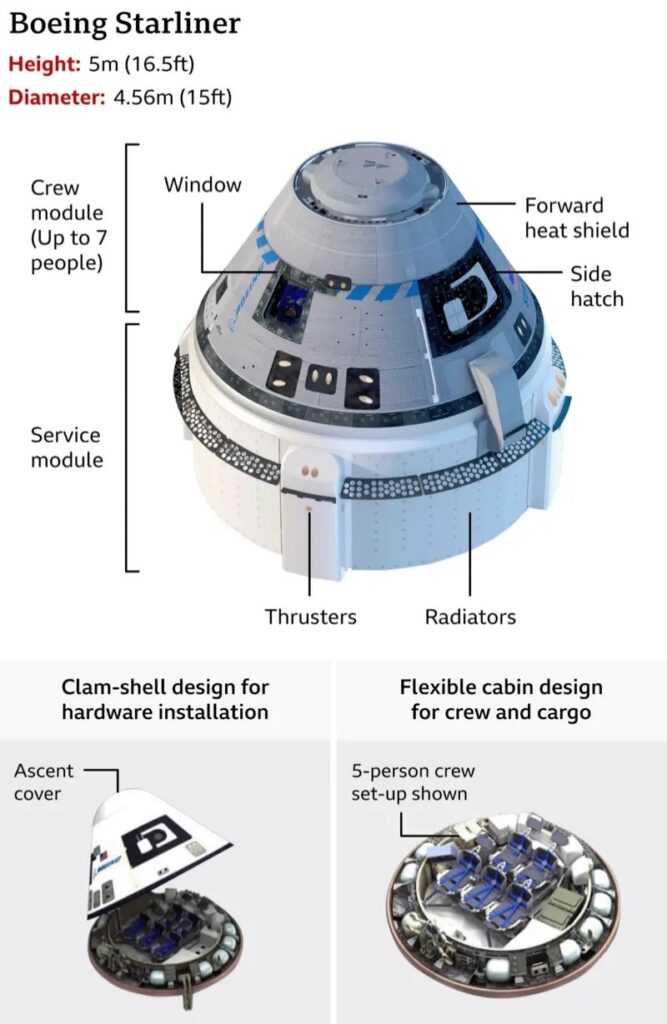The two astronauts testing Boeing’s new spacecraft, Starliner, were scheduled to begin their return to Earth on Wednesday night, but will instead remain at the International Space Station (ISS).

The spacecraft’s return to Earth was already delayed due to problems with some engines and a leak in the helium gas that fuels the propulsion system.
NASA is conducting a thorough review of the technical issues before deciding when to return the astronauts.
Suni Williams and Butch Wilmore are not in danger, but what happened with the spacecraft? What does it mean for their return?
Starliner launched on June 5 despite a small helium gas leak. Helium is used to fuel the engine system used for maneuvering in space and slowing down re-entry into Earth’s atmosphere.
The leak was so small that engineers determined it would not affect the mission and continued with the launch.
However, four more helium leaks occurred during the mission, and five of the 28 maneuvering engines failed during the approach to the space station, four of which had to be restarted.
The mission was scheduled to last eight days, but the return date was postponed while engineers investigated the problems.
Then on June 18, NASA announced that Starliner would begin its return journey on Wednesday, June 26 at 10 pm Eastern Time (Thursday, June 27 at 3 am BST).
NASA had previously said in a blog post that the leak posed no safety risk to astronauts: “Only seven hours of free flight time is needed for a normal end of mission and there is currently enough helium remaining in Starliner’s tanks.
But a few days later, following a high-level meeting, NASA concluded that the planned return date should be “adjusted” to July. No further information was provided on why the decision was changed.

NASA said it wanted onboard engineers to examine the spacecraft before it re-enters Earth’s atmosphere to get to the bottom of the problem. That’s because Starliner’s faulty lower “service module” would burn up during atmospheric re-entry as the crew capsule parachutes to Earth, losing some information about what went wrong.
The space agency stressed that no astronauts were left behind and that Starliner was certified to return to Earth in the event of an emergency on the ISS.
What happens next will undergo a high-level “agency-level review” by NASA to determine what to do next.

Given the chain of events, the question is whether the launch should have gone ahead despite the leak.
Dr. Adam Baker, head of Rocket Engineering, a British company specializing in rocket propulsion systems, said he understood why the launch happened, but it would have been better to find the source of the leak and fix it.
“There are risks in trying to make everything perfect, and in the end it takes too long, costs too much, and you lose public and political support,” he said.
“But I feel like there wasn’t enough consideration given to the worsening of the leak after launch, which is probably something NASA and Boeing should have done.
It would have been hugely expensive, as they would have had to fire the rocket off the pad and remove the propulsion system from the spacecraft.” Another issue NASA is looking into, according to Dr. Simeon Barber, a space scientist at the Open University, explained why these problems were not found during either of Starliner’s two previous unmanned flight tests.
“The issues we’ve seen in recent weeks are not the kind of issues we would have expected at this stage in the Starliner development program,” he said.
“The objective was to test the impact on performance if astronauts were involved in controlling the spacecraft. Rather, we appear to be addressing a more fundamental issue that should have been resolved by now.”

Finally, there is the important issue of NASA admitting the root cause of the helium leak and identifying the engine problem. Until this happens, risk analyses and emergency response plans for the safe return of astronauts will be incomplete, said Dr. Barber.
“Until the root cause is understood, we have to make a decision to return home based on incomplete information. Without a full understanding of the cause of the failure, we cannot be certain that it is not a systemic issue affecting not only the main propulsion system but also the backups.”
As a last resort, NASA and Boeing could consider returning to SpaceX’s Dragon capsule, which brings astronauts, which would be very embarrassing for Boeing. But according to Dr. Baker, not yet.
“With any new spacecraft, you have to expect the unexpected,” he says. “This is a completely expected failure, and I don’t think it’s a major concern, other than that it will need to be analyzed and resolved before the next crewed flight.”

